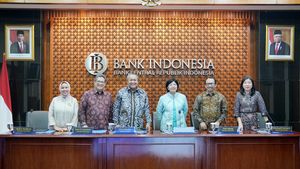JAKARTA - The Indonesian government targets the building sector to contribute to reducing greenhouse gas emissions by 1.91 million tons of equivalent CO2 by 2030.
Director of Settlement and Housing Engineering Development of the Ministry of Public Works and Public Housing (PUPR) Dian Irawati said the government is trying to reduce greenhouse gas emissions from the building sector through various strategies, including encouraging the construction of green buildings, increasing energy efficiency, and utilizing roof PLTS, both in government buildings, office buildings, and residential areas.
"We have also compiled a road map for the implementation of green buildings (BGH) which is a reference for implementation for all policy makers from building operations," said Dian quoting Antara.
Dian added that to achieve this target, the government also encourages the application of the concept of passive design in buildings, which prioritizes the efficient use of natural resources and the application of new and renewable energy.
On the same occasion, Fajar Santosa Hutahaean from the Directorate of Settlement Engineering and Housing at the Data and System Development Section of PUPR added that the roadmap for the construction of the green building will be prioritized in the public sector.
This is based on data showing that government buildings tend to have higher energy consumption than commercial buildings.
He said that if all government offices turn to green concepts and manage to save energy by 25 percent, it is estimated that it can reduce carbon emissions to 1.91 million tons of equivalent CO2 by 2023.
"Why is it in government offices that are priorities? Because based on PLN data, during the COVID-19 period in 2019-2020, the use of electricity for commercial, business, and others fell 6-8 percent, while government offices fell by only 2 percent," he said.
SEE ALSO:
According to the Regulation of the Minister of PUPR Number 21 of 2021 concerning the Performance Assessment of Green Building Buildings, green buildings or BGHs are buildings that meet the technical standards of buildings and have a significant measurable performance in energy savings, water, and other resources through the application of BGH principles in accordance with the functions and classifications in each stage of its implementation.
Based on data from the Ministry of PUPR, up to now there are 10 buildings, one area, and five housing that have been certified as Green Building Building Building (BGH).
Based on Presidential Decree No. 98 of 2021, building buildings are considered as part of the energy sector and have an important role in the implementation of climate change mitigation actions.
In the Enhanced Nationally Determined Contributions (ENDC) target, Indonesia set a 31.89 percent reduction in greenhouse gas emissions through domestic efforts and 43.2 percent with international assistance by 2030.
The English, Chinese, Japanese, Arabic, and French versions are automatically generated by the AI. So there may still be inaccuracies in translating, please always see Indonesian as our main language. (system supported by DigitalSiber.id)
















